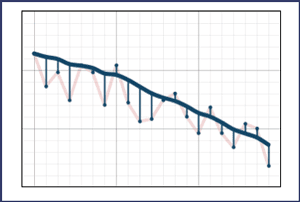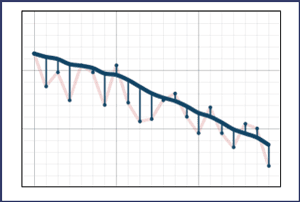You've created the perfect program.
Your nutrition plan is spot on.
With everything in place, you're expecting your client to be in awe over your excellence.
Instead, their weight hasn't dropped in 2 weeks -- and they're blaming you.
What's going on? Are you getting punished for something you can't control, even though your client is on the right track?
There are many factors that affect the number on the scale, but clients just want to see it drop, and fast. The reality is that the scale doesn't matter, but you've got some work ahead of you to convince your client of it.
Step 1: Educate Your Clients
"The best way to empower clients is to educate them."
The more they know, the fewer problems you have to deal with and the less anxiety they'll experience.
Explain to them that their weight is affected by these several factors:
Fat
This is the obvious one, and any rise in the scale number will surely be perceived as fat.
In reality, fat is lost and gained at relatively moderate rates. For very overweight clients, 3-4 pounds lost per week might be attainable (but extreme) and for very lean clients, a half to 1 pound per week will be all you can get.
To gain 1-3 pounds of fat would require 3500-10,500 calories over what they burn each week, which equates to 500-1500 calories over per day.
While it is possible to eat that much (you don't want to see what my cheat days look like), it's extremely unlikely if they're sticking to their diet. It's even less likely that they'd be eating that much every day.
So when the scale jumps up and down several pounds over the course of a few days, reassure them that fat isn't the major culprit. Something else is going on.
Muscle
Much like fat, muscle is gained and lost at slower rates.
The difference is that while muscle gain on a fat loss program will be slow (if it happens at all), muscle loss can cause weight to drop quicker than expected.
That's because muscle only contains around 500 burnable calories from protein. If your client runs a 500-calorie deficit each day and only burns muscle (which is highly unlikely), they have the potential to drop up to 7 pounds without losing any fat.
Compare that to the 1 pound of fat they would've lost had that same deficit came from only fat.
Make sure your clients know that faster weight loss isn't always a good thing.
Stomach Content
Besides actual changes in fat and muscle, the food eaten from day to day can cause big swings in weight as well.
It's easy to overlook, but simply having more food in the gut (undigested or what's left after digestion) adds to their weight. Drinking only protein shakes will keep stomach content minimal, while lots of fibrous veggies and hearty servings of meat (which is recommended), will have your client carrying much more "non-energy" food components that press down on the scale.
This goes for water as well. If your client chugs a liter of water, they'll weigh 2-3 pounds heavier just from the sheer fact of that liquid sitting in their stomach.
Carbs
Carbs are especially good at messing with weight, since they get stored in muscle and weigh more per calorie than fat (4 kcal/g compared to 9 kcal/g for fat).
And when they get stored in muscles as glycogen, they bring in around 3 times the amount of water, adding to even more weight gain.
If your client eats out one night at an Italian restaurant, where food is abundant and the pasta flows freely, they might end up heavier simply due to storing more glycogen. The same can happen after purposeful carb refeeds.
Your clients will be less likely to freak if they know what's coming and why.
Sodium
Similar to carbs, increasing sodium intake can also cause water retention, adding weight to the ticker.
The trick with sodium, however, is that your clients' bodies will respond based on their habitual intake.
That means if they're used to eating 2,000 mg per day and then bump it up to 3,000 mg one shameful night while polishing off a jar of pretzels, they're likely to hold onto water from the increase.
But if they normally consume 3,000 mg, that night probably won't have much of an effect, since it's within their normal intake.
When assessing a weight bump in a client, be sure to consider any deviations from their normal sodium consumption.
Creatine
Creatine is one of the few supplements that's been shown through research to boost strength and power.
Your client might be excited to start taking creatine and reaping the benefits, but they won't be excited if they aren't prepared for the 2-3 pound gain that comes with it.
Similar to glycogen, creatine is stored in the muscle and draws water in with it. This is a good thing as it swells the cells and increases protein synthesis and cell signaling, but the only thing your client will notice is the scale laughing in their face.
Prepare them for the gain before they start taking it so they won't be shocked.
Cortisol and Stress
This is easily the most frustrating factor, as it's incredibly hard to measure, and can stall your client's weight for several weeks.
Cortisol causes water retention (through cross-reactivity with the aldosterone receptor), meaning that elevated levels can mask fat loss.
It just so happens that dieting and exercise both increase cortisol.
Typically, a bigger calorie deficit and more total exercise (usually cardio) will increase cortisol to the point where weight loss becomes erratic and unpredictable.
But things like lack of sleep, big lifestyle stresses, and injuries can also raise cortisol.
If you suspect this is the problem for your client, the solution is easy: remove the stress.
Well, maybe not easy, but simple.
Reduce the calorie deficit, cut back on cardio, and encourage them to chill out and get some sleep. If cortisol is the culprit, these changes should help your client drop that extra water and show they're true weight.
Education Goes a Long Way
Make it clear that their weight can fluctuate 5-10 pounds from the above factors alone. That's huge.
Remind them to be patient and amazing results will come.
As a bonus, teaching them about the above factors will allow you to show off your knowledge and increase your credibility.
Step 2: Use All Your Tools
While the scale is useful, it only tells part of the story.
Make sure your client knows there are several different ways to measure progress, and that incorporating all of them will give a more accurate picture.
To make sure your client sees the overall picture, use each of these tools along with the scale so they get the best results.
Body Tape Measurements
Taking body measurements is one of the best methods to track progress.
With effective programs, it's not uncommon for clients to gain some muscle while losing fat. But you know what that means: the number on the scale stays the same (or even increases).
If the scale is all they're looking at, they're sure to miss some of the magic that's occurring.
To remedy this, remind clients to take weekly or bi-weekly measurements at the following spots on their bodies':
- Right Arm Straight, Left Arm Straight
- Right Arm Flexed, Left Arm Flexed
- Right Leg Straight, Left Leg Straight
- Shoulders at widest point
- Chest at widest point
- Upper stomach, just below sternum
- Middle stomach, at bottom of rib cage
- Lower stomach, just below belly button
- Hips, at widest point
Check out this video to learn how to measure at each of these spots:
The main spots you'll want to see inches lost are the stomach and hips, but all measurements will usually go down when losing fat.
A loss of a quarter to half an inch per week from the waist is a very good rate of loss, but this is extremely dependent on the person (weight, height, body fat percentage, fat distribution, muscle distribution, etc.).
Some clients may lose more from their hips, while some may lose more from their upper stomach first before losing from their lower stomach. Leaner clients will lose inches slower, while very heavy clients can lose inches rather quickly.
The important thing to pay attention to is the pattern in each particular client.
Have them pick a realistic end-goal for these measurements (dropping anywhere from 2-6" in their waist in 12 weeks, for example), and follow their progress to determine if they'll reach their goal within their timeline.
Even if their weight doesn't budge, they'll see the measurements heading in the right direction.
Performance in the Gym
Pay attention to how your client is doing in the gym. Are they getting stronger? Can they do more reps? Are they resting less?
The quality of their workouts can tell you a lot about what's going on with their body.
If they're improving or even maintaining while dieting, you can be sure that they're on the right track.
But if they start losing strength or moping around the gym like a slug with a hangover, you can be sure something is amiss. Be sure to fix the problem by changing their training and/or diet.
No matter what, never stop tracking personal training clients.
Progress Photos
Body weight, measurements, and gym performance are all indirect measures of a client's true goal: to look better!
It only makes sense then to measure how they look.
Unfortunately memory and the mirror can be very misleading. Did they really get leaner or are they sucking their gut in? Can you (or can they) honestly remember exactly what they looked like a few weeks ago?
Taking photos eliminates the bias and allows you (and them) to objectively compare changes. It also allows your clients to see which particular parts of their body they'd like to focus on.
Not all clients will jump at the idea of taking picture of themselves. Pictures don't hide flaws and weaknesses, and it can be hard to face the truth.
This step is crucial to objectively view results, and it will flip the motivation switch in your clients' heads. If they have that photo staring back at them, they'll be sure to work as hard as they can to fix it.
When bringing up the idea to them, be sure to tell them why photos are necessary, and how it will help them reach their goal:
"Hey , as we move forward, I'd like you to take progress photos once every month so we'll both be able to compare your results. I know it might be uncomfortable, but it will help me guarantee that you'll transform your body, and it will motivate you to keep improving. Does that sound good to you?"
Then go on to describe the details of what you need from the photos:
- Have them take 3 photos: Front, side, and back.
- Tell them to stand up straight, but relaxed
- Make sure the photos are taken under the same conditions (lighting, distance from camera, angle, time of day, etc.).
- Ask them to use the "bathing suit" rule: show what you're able to on the beach. That means shorts for guy and bikini for girls.

If there's any particular body part they want to focus on, be sure to include close up shots so you can judge progress solely for that muscle group.
Step 3: Weigh Clients Differently
If your client knows why their weight isn't dropping, even if other measurements are improving, he or she may still get frustrated when the scale doesn't budge.
Luckily, there's one more trick you can use.
It's called a "Rolling Average" and using it smoothes out the random spikes and dips in weight.
To do this, simply add up your client's most recent 3-10 weigh-ins and divide by the number of measurements used.
Each time they add a new measurement, recalculate their current weight by dropping the oldest one and adding in the new one.
I prefer using a 1-2 week time span, depending on the number of readings you take. Use the following guidelines when calculating a rolling average:
- If your client records their weight daily (recommended for rolling averages), calculate an average from the past 7-10 days
- If your client records their weight 2-3 times per week, take an average from the past 4-6 measurements
- If your client records their weight only once per week, use an average from the past 3-4 weeks
This helps eliminate the random fluctuations that can so easily mess with their head, and keeps their expectations realistic.
If they drop 3 pounds overnight, the rolling average will show a more modest and gradual drop over time (assuming they maintain that weight or continue to drop).

Photo property of Happy Scale.
On the other hand, if their weight spikes up 5 pounds one day because they spent the night in Cancún downing salty margaritas and chowing on some nachos, then they won't be as upset with themselves.
Just make sure they ignore their actual weight and use the rolling average as their metric of progress.
Pro tip: Create an Excel spreadsheet and enter in formulas to do the work for you. And if you really don't feel like calculating the averages on your own, there's an app called "Happy Scale" that will do it for you.
Step 4: Get the Praise You Deserve
At the end of the day, you're working hard for your clients. You're putting them on the right track, so do your best to avoid getting blamed for natural weight shifts.
Remember these key points:
- Educate your clients that weight is composed of many different factors -- not just fat
- Track progress in a variety of ways, including tape measurements, performance in the gym, and progress photos
- Use rolling averages to smooth out random weight changes
Now when you check in with your clients, they'll be ecstatic over their progress. They'll be able to see steady changes and you'll finally get the praise you deserve and that is how to make it as a personal trainer.










